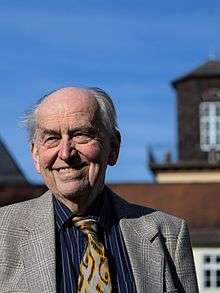Siegfried Grossmann
Siegfried Grossmann (born 28 February 1930) is a German theoretical physicist who has been awarded the Max Planck Medal, the major prize for achievements in theoretical physics.

Biography
He was born near Königsberg in Prussia (now Kaliningrad, Russia) and educated at the Pedagogical High School in Berlin, where he graduated in teaching. Whilst training to be a teacher he studied physics, mathematics and chemistry at the Free University of Berlin.
In 1959 he became an assistant at the university to Günther Ludwig, a respected German theoretical physicist and was promoted to study the inelastic scattering of Hydrogen molecules. He qualified two years later with a work on Quantum Mechanics and from 1963 worked as a conservator at Munich Technical University. In 1964 he obtained an extraordinary professorship at the University of Marburg, to which his mentor Ludwig had already moved. In 1968 he was given a full professorship in theoretical physics, retiring in 1998.
He is married with three children.
Research
He is considered one of the founders of nonlinear dynamics and chaos theory. His work on turbulence contributed to an understanding of the transition from laminar to turbulent flow. He provided contributions to the description of a laser using nonlinear dynamics. With Stefan Thomae he produced a value for the Feigenbaum constant.[1]
He is also one of the leading theoreticians in the fields of fluid dynamics and theory of turbulence, stochastic processes, phase transitions, laser physics, nuclear physics, transport theory, Bose-E instein condensation and the general statistical physics, as well as mathematical physics and functional analysis.
Honours and awards
In 1991 he was elected a member of the European Academy of Sciences and Arts. In 1995 he was awarded the prestigious Max Planck Medal for outstanding achievements in the field of theoretical physics.[2] In 2006 he received a doctorate from the University of Duisburg-Essen for his work on the theory of turbulence and non-linear dynamics.
At the age of 90 he is still scientifically active, publishing research papers every year and giving lectures at conferences and seminars.
Publications
Grossmann wrote over 200 publications in various fields of physics.
He also wrote two textbooks on the mathematical foundations of classical theoretical physics and quantum mechanics:
- Mathematical introductory course for physics. Teubner, Stuttgart. ISBN 3-519-13074-2.
- Functional analysis with regard to applications in physics: Study book for students of physics and mathematics at universities and technical colleges. Aula Publishing House, Wiesbaden. ISBN 3-89104-479-8.
References
- "LAUDATIO in Honour of Professor Siegfried Grossmann of the University of Marburg, Germany" (PDF). CAMTP. Retrieved 11 March 2017.
- "Max-Planck-Medaille". Deutsche Physikalische Gesellschaft. Retrieved 11 March 2017.
- Based on a translation of the equivalent article on German language Wikipedia